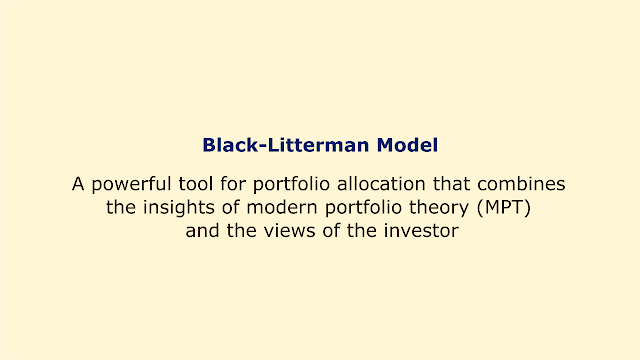 |
| Image: Moneybestpal.com |
The Black-Litterman model is a powerful instrument for portfolio allocation that combines the perceptions of the investor and the insights of modern portfolio theory (MPT). MPT is a well-known framework for determining the best portfolio that either minimizes risk for a given level of expected return or maximizes expected return for a given level of risk.
However, MPT has some limitations, such as:
- The projected returns and covariances of the assets are estimated using historical data, which might not be representative of current market conditions or investor attitudes.
- It frequently results in extremely concentrated portfolios that are vulnerable to even modest changes in the input parameters, which the investor may not find acceptable or feasible.
The Black-Litterman model, created in 1990 at Goldman Sachs by Fischer Black and Robert Litterman, addresses these problems by taking into account the investor's predictions for the future performance of the assets and adjusting the portfolio weights in accordance with the degree of their confidence.
Beginning with an equilibrium portfolio, the Black-Litterman model assumes that the assets will continue to perform as they have in the past. This portfolio, which reflects the consensus opinion of the market, is derived from the market capitalization weights of the assets. The model then adjusts this portfolio by considering the investor's predictions for how some or all of the assets will deviate from their equilibrium returns.
The investor can express their views in different ways, such as:
The Black-Litterman model can be applied in practice using various methods and software tools, such as Excel spreadsheets, MATLAB programs, or specialized portfolio optimization software. The main steps involved are:
The Black-Litterman model is a versatile and reliable way to include both market information and individual perspectives in portfolio allocation. Investors are able to communicate their opinions in a consistent, natural way, and to modify their portfolios as necessary. Additionally, it outperforms MPT by staying away from extreme and unstable portfolios and by offering more accurate and trustworthy estimates of predicted returns and covariances.
- Absolute views: The investor specifies a certain expected return for an asset or a group of assets.
- Relative views: The investor specifies a certain difference in expected return between two assets or groups of assets.
Each opinion is given a confidence level by the investor, which expresses how strongly they hold that opinion in contrast to the consensus of the market. The view will be given greater weight in the final portfolio the higher the confidence level.
The Black-Litterman model then employs a Bayesian approach to integrate the equilibrium portfolio with the investor's opinions, yielding a new set of anticipated returns and covariances that take into account both data sources. The model also makes sure that the new portfolio is stable and well-diversified, and that it doesn't go too far from the equilibrium portfolio unless the investor's opinions provide compelling justification.
The Black-Litterman model can be applied in practice using various methods and software tools, such as Excel spreadsheets, MATLAB programs, or specialized portfolio optimization software. The main steps involved are:
- Define the set of assets and their market capitalization weights.
- Estimate the risk aversion parameter and the risk-free rate.
- Calculate the equilibrium returns and covariances using a reverse optimization technique.
- Specify the investor's views and their confidence levels.
- Combine the equilibrium portfolio and the investor's views using a Bayesian formula.
- Perform a mean-variance optimization using the new expected returns and covariances to obtain the optimal portfolio weights.
The Black-Litterman model is a versatile and reliable way to include both market information and individual perspectives in portfolio allocation. Investors are able to communicate their opinions in a consistent, natural way, and to modify their portfolios as necessary. Additionally, it outperforms MPT by staying away from extreme and unstable portfolios and by offering more accurate and trustworthy estimates of predicted returns and covariances.
